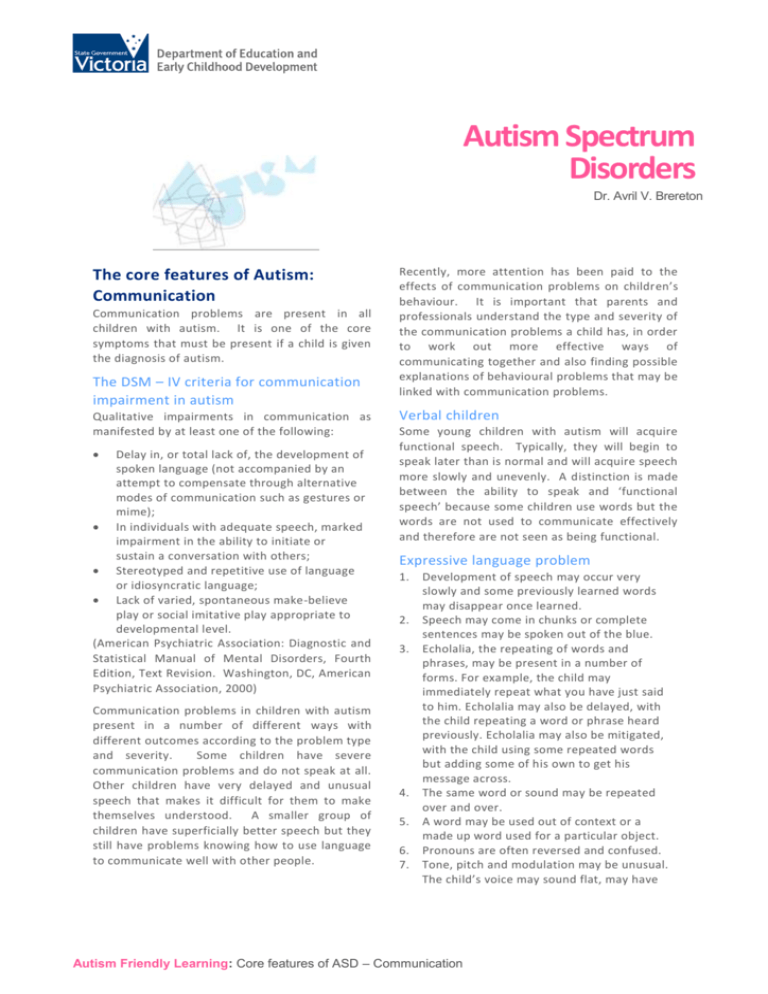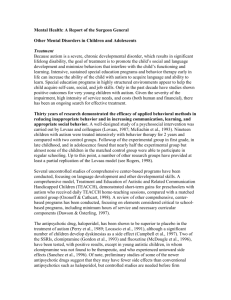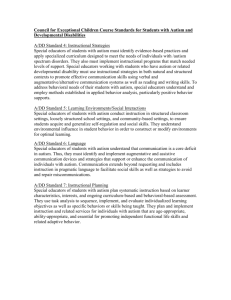The core features of autism – communication (doc 3 (docx
advertisement

Autism Spectrum Disorders Dr. Avril V. Brereton The core features of Autism: Communication Communication problems are present in all children with autism. It is one of the core symptoms that must be present if a child is given the diagnosis of autism. The DSM – IV criteria for communication impairment in autism Qualitative impairments in communication as manifested by at least one of the following: Delay in, or total lack of, the development of spoken language (not accompanied by an attempt to compensate through alternative modes of communication such as gestures or mime); In individuals with adequate speech, marked impairment in the ability to initiate or sustain a conversation with others; Stereotyped and repetitive use of language or idiosyncratic language; Lack of varied, spontaneous make-believe play or social imitative play appropriate to developmental level. (American Psychiatric Association: Diagnostic and Statistical Manual of Mental Disorders, Fourth Edition, Text Revision. Washington, DC, American Psychiatric Association, 2000) Communication problems in children with autism present in a number of different ways with different outcomes according to the problem type and severity. Some children have severe communication problems and do not speak at all. Other children have very delayed and unusual speech that makes it difficult for them to make themselves understood. A smaller group of children have superficially better speech but they still have problems knowing how to use language to communicate well with other people. Recently, more attention has been paid to the effects of communication problems on children’s behaviour. It is important that parents and professionals understand the type and severity of the communication problems a child has, in order to work out more effective ways of communicating together and also finding possible explanations of behavioural problems that may be linked with communication problems. Verbal children Some young children with autism will acquire functional speech. Typically, they will begin to speak later than is normal and will acquire speech more slowly and unevenly. A distinction is made between the ability to speak and ‘functional speech’ because some children use words but the words are not used to communicate effectively and therefore are not seen as being functional. Expressive language problem 1. 2. 3. 4. 5. 6. 7. Development of speech may occur very slowly and some previously learned words may disappear once learned. Speech may come in chunks or complete sentences may be spoken out of the blue. Echolalia, the repeating of words and phrases, may be present in a number of forms. For example, the child may immediately repeat what you have just said to him. Echolalia may also be delayed, with the child repeating a word or phrase heard previously. Echolalia may also be mitigated, with the child using some repeated words but adding some of his own to get his message across. The same word or sound may be repeated over and over. A word may be used out of context or a made up word used for a particular object. Pronouns are often reversed and confused. Tone, pitch and modulation may be unusual. The child’s voice may sound flat, may have Autism Friendly Learning: Core features of ASD – Communication an unusual accent or may be too loud or too soft. Receptive language or comprehension problems 1. 2. 3. 4. Difficulty understanding the meaning of what other’s say. Difficulty understanding a sequence of instructions. Lack of understanding of metaphor, e.g. “shake a leg”. Literal use of language and interpretation of what other’s say, e.g. “pull your socks up”. There is also a range of difficulties that verbal children have with conversation. Children with autism usually have difficulty attending to other people. Conversation relies on two people listening to each other and taking turns to speak. For children with autism, this is a particular problem. Although they may have a lot of useful speech, they do not speak conversationally. The child with autism is more likely to talk at you rather than with you. Initiating and sustaining a conversation are also areas of difficulty. Some verbal children may have special topics they want to talk about to the exclusion of all else, or may bombard you with questions that no answer you give seems to satisfy. Non-verbal children Some children with autism do not acquire functional speech. It is still not clear why this is so. Some argue that it is because children with autism have such strong underlying social deficits and problems with joint attention. Others argue that it is because in autism there is a basic lack of understanding that people have thoughts and feelings that can be related to in the first place. Whatever the cause, children who are non-verbal must be able to convey their needs and desires to others in some way other than speech. It is important to assess how the non-verbal child expresses his/her needs and gets her/his message across to others. Improving non-verbal communication using augmentative systems Follow up studies have shown that for most children with autism who do not have useful speech by about the age of seven years, it is likely that their ability to communicate verbally will remain severely impaired. It is important for these children to have some form of augmentative communication system. Augmentative communication helps children who don’t have speech to communicate by using other systems. These systems are called “augmentative” because they augment or increase the strength of the child’s power to communicate. Simple pictures and line drawings such as Compic or PECS, signing systems such as Makaton and also photographs are often used to augment communication for children with autism. Signing Signing was probably the first alternate system used with non-verbal children with autism. At first, the signing systems used by the deaf were taught, but these are complex systems that require finger spelling of words and use abstract concepts. In the early 80’s, a simpler system called Makaton was devised to use with children with intellectual disability. This system has varying degrees of difficulty, but at its earliest level, signs are simple, concrete and do not require difficult finger spelling. Many of the first signs use only one hand. For example, the sign for drink uses one hand in the shape of a cup that is lifted to the mouth and tilted as if the child were having a drink. One advantage of signs is that they are very portable and do not require the child to carry around equipment. Another advantage of establishing a signing system is that it has been found to encourage speech in children contrasting to what some parents fear, that signing might reduce the chance of their child talking. However, signing is not widely understood in the community and the child may not always be well understood outside the circle of those who can sign with him/her. Signing also requires that the child attends to the person teaching the signs and is able to imitate an action. Computer generated pictures and the Picture Exchange Communication System Computer generated pictures are communication resources that are successfully used in many teaching programmes. These pictures consist of simple and clear line drawings that represent a wide range of objects, actions and feelings. They can be used initially at a very simple, but practical level with young children who learn to point at the picture or show the picture to indicate their needs. When children are familiar with a number of these pictures, they can be put into a wallet of pictures that the child carries with him and uses Autism Friendly Learning: Core features of ASD – Communication to indicate his needs. The child gradually builds up a vocabulary of pictures to meet his own special needs. Computer generated picture programmes are widely available in both computer software and loose-leaf book formats. Compic and Boardmaker are two such programmes and there are some more recent programmes. The pictures are easily understood by everyone and do not require the child to learn and remember complex actions, as does signing. Children who have low cognitive skills can generally use a picture system in a simple way to communicate more effectively. The Picture Exchange Communication System (PECS) (Frost and Bondy, 1994) is another augmentative communication system. Developed in the early 90s, PECS is widely used in early intervention and school programmes to teach children how to initiate communication. An advantage of this system is that it does not require complex or expensive materials and can be used in a variety of settings by parents, carers and teachers. PECS begins with teaching a student to exchange a picture of a desired item with a teacher who immediately honours the request. Verbal prompts are not used. Once this step is mastered, the system goes on to teach discrimination of symbols and later simple "sentences” are made from stringing together these symbols. Children can also learn to comment and answer direct questions using the Compic system symbols. Photographs and objects Photographs of objects, activities and people in the child’s world can also be used effectively with low functioning children who cannot master the use of symbols or line drawings. Use of photographs usually requires that the child first learns to match an actual object with an exact photograph of the object. The child learns that the photograph represents the object. The photograph must be simple, clear and uncluttered. After the child has learnt to match photographs and objects, the more complex concept of matching photograph and activity or action can be taught. completing an activity. For example, the classroom may have photographs of the day’s activities pinned to the wall. When each activity finishes, the child may put away that photograph. Similarly, when the child is required to get dressed, the steps involved may be pinned to his bedroom door in the correct sequence and easily followed. Objects can be used in a similar way to photographs with children who have difficulty understanding photographs. Object time-tables are useful. Objects that represent activities can be laid out or stuck on the wall to show the child what happens next. For example, a crayon means work at the table, and the next object is a juice box straw to indicate that snack time comes after work. A great advantage of photographs and objects is that the child can attend to them for as long as he needs to, and also return to them to refresh his memory. This is not possible with a sign which is gone once it has been demonstrated. Each child must be carefully assessed to determine which system will suit best. The majority of children with autism have delayed imitation skills but better developed visual recognition skills. Therefore a picture based system may be more suitable than a signing system. Ultimately, the choice of system to help improve the child’s communication will depend upon his/her level of cognitive and language ability and developmental profile of strengths and weaknesses. Once the child is able to recognise a number of photographs, a photo vocabulary can be built up in the same way as a Compic vocabulary. Photographs can be used to help the child understand time tables or the steps involved in Autism Friendly Learning: Core features of ASD – Communication References American Psychiatric Association (2000). Diagnostic and Statistical Manual of Mental Disorders (Text revised). Washington, DC: American Psychiatric Association Press. a developmental perspective – Article by K. Hogan (TEACCH) American Speech – Language – Hearing Association (1991). Report: Augmentative and Alternative Communication. 33 Suppl. 5, 9-12 Boucher, J. (1999). Child Language Teaching and Therapy, Vol. 15, No. 1, 1-5 Brereton, A., and Tonge, B. (2005) Preschoolers with Autism: An Education and Skills Training Programme for Parents. Jessica Kingsley. London. Finnerty, J. & Quill, K. Communication Analyser. Educational Software research. (1991). The Lexington. Frost, L. and Bondy, A. (1994). The Picture Exchange Communication System: Training Manual. Newark, DE: Pyramid Educational Consultants, Inc. Goldstein, H. (2002). Communication Intervention for Children with Autism: A Review of Treatment Efficacy, Journal of Autism and Developmental Disorders. Volume 32, Number 5, 373-396. Hodgon, L.A. (1995). Visual strategies for improving communication. Troy, Mich.: Quirk Roberts Publishing. Hodgon, L.A. (1999). Solving behaviour problems in autism: Improving communication and visual strategies. Quirk Roberts Publishing. Potter, P. and Whittaker, C. (2001) Enabling Communication in Children with Autism. London: Jessica Kingsley Publishers Quill, K.A. (2000). Do-Watch-Listen-Say: Social Communication Intervention for Children with Autism. Baltimore, MD: Paul H. Brookes Schuler et al. (1989). Assessment of communicative means and function through interview: Assessing the communicative capabilities of individuals with limited language. Seminars in Speech and Language. 10. 51-61. Sussman, F. (1999). More than Words. Canada: The Hanen Programme Nonverbal thinking, communication, imitation, and play skills - from Autism Friendly Learning: Core features of ASD – Communication







